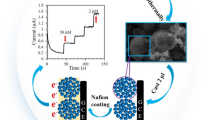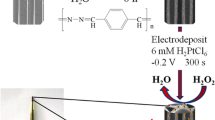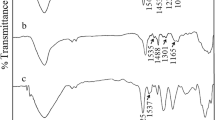Abstract
An amperometric biosensor for hydrogen peroxide (H2O2) has been constructed by immobilizing cytochrome c on an indium/tin oxide (ITO) electrode modified with a macroporous material. Cyclic voltammetry showed that the direct and quasi-reversible electron transfer of cytochrome c proceeds without the need for an electron mediator. A surface-controlled electron transfer process can be observed with an apparent heterogeneous electron-transfer rate constant (ks) of 29.2 s−1. The biosensor displays excellent electrocatalytic responses to the reduction of H2O2 to give amperometric responses that increase steadily with the concentration of H2O2 in the range from 5 μM to 2 mM. The detection limit is 0.61 μM at pH 7.4. The apparent Michaelis-Menten constant (Km) of the biosensor is 1.06 mM. This investigation not only provided a method for the direct electron transfer of cytochrome c on macroporous materials, but also established a feasible approach for durable and reliable detection of H2O2.

Biosensor for hydrogen peroxide was developed by immobilizing cytochrome c in the macroporous ordered silica foam (MOSF) through the electrostatic interaction. The achievement of the direct electron transfer between cytochrome c and electrode surface indicated that the MOSF modified electrode displayed good affinity and biocompatibility for cytochrome c.








Similar content being viewed by others
References
Halliwell B (1992) Reactive oxygen species and the central-nervous-system. J Neurochem 59(5):1609–1623
Hall ED, Braughler JM (1989) Central nervous-system trauma and stroke II. Physiological and pharmacological evidence for involvement of oxygen radicals and lipid-peroxidation. Free Radical Bio Med 6(3):303–313
Maruyama W, Dostert P, Matsubara K, Naoi M (1995) N-Methyl(R)Salsolinol produces hydroxyl radicals—involvement to neurotoxicity. Free Radical Bio Med 19(1):67–75
Amatore C, Arbault S, Bruce D, de Oliveira P, Erard M, Vuillaume M (2001) Characterization of the electrochemical oxidation of peroxynitrite: relevance to oxidative stress bursts measured at the single cell level. Chem-Eur J 7(19):4171–4179
Miller EW, Albers AE, Pralle A, Isacoff EY, Chang CJ (2005) Boronate-based fluorescent probes for imaging cellular hydrogen peroxide. J Am Chem Soc 127(47):16652–16659
Clarkson DT, Carvajal M, Henzler T, Waterhouse RN, Smyth AJ, Cooke DT, Steudle E (2000) Root hydraulic conductance: diurnal aquaporin expression and the effects of nutrient stress. J Exp Bot 51(342):61–70
Hurdis EC, Romeyn H (1954) Accuracy of determination of hydrogen peroxide by cerate oxidimetry. Anal Chem 26(2):320–325
Matsubara C, Kawamoto N, Takamura K (1992) Oxo[5,10,15,20-Tetra(4-Pyridyl)Porphyrinato] Titanium(Iv)—an ultra-high sensitivity spectrophotometric reagent for hydrogen-peroxide. Analyst 117(11):1781–1784
Zhang GF, Dasgupta PK, Edgemond WS, Marx JN (1991) Determination of hydrogen-peroxide by photoinduced fluorogenic reactions. Anal Chim Acta 243(2):207–216
Rosenzweig Z, Kopelman R (1996) Analytical properties and sensor size effects of a micrometer-sized optical fiber glucose biosensor. Anal Chem 68(8):1408–1413
Luo LR, Zhang ZJ (2006) Sensors based on galvanic cell generated electrochemiluminescence and its application. Anal Chim Acta 580(1):14–17
Rocha FRP, Rodenas-Torralba E, Reis BF, Morales-Rubio A, de la Guardia M (2005) A portable and low cost equipment for flow injection chemiluminescence measurements. Talanta 67(4):673–677
Pinkernell U, Effkemann S, Karst U (1997) Simultaneous HPLC determination of peroxyacetic acid and hydrogen peroxide. Anal Chem 69(17):3623–3627
Lai GS, Zhang HL, Han DY (2009) Amperometric hydrogen peroxide biosensor based on the immobilization of horseradish peroxidase by carbon-coated iron nanoparticles in combination with chitosan and cross-linking of glutaraldehyde. Microchim Acta 165(1–2):159–165
Zhang Y, Luo LQ, Ding YP, Liu XA, Qian ZY (2010) A highly sensitive method for determination of paracetamol by adsorptive stripping voltammetry using a carbon paste electrode modified with nanogold and glutamic acid. Microchim Acta 171(1–2):133–138
Che X, Yuan R, Chai YQ, Ma LP, Li WJ, Li JJ (2009) Hydrogen peroxide sensor based on horseradish peroxidase immobilized on an electrode modified with DNA-L-cysteine-gold-platinum nanoparticles in polypyrrole film. Microchim Acta 167(3–4):159–165
Song J, Xu JM, Zhao PS, Lu LD, Bao JC (2011) A hydrogen peroxide biosensor based on direct electron transfer from hemoglobin to an electrode modified with Nafion and activated nanocarbon. Microchim Acta 172(1):117–123
Xu SX, Zhang XF, Wan T, Zhang CX (2011) A third-generation hydrogen peroxide biosensor based on horseradish peroxidase cross-linked to multi-wall carbon nanotubes. Microchim Acta 172(1):199–205
Lee KP, Gopalan AI, Komathi S (2009) Direct electrochemistry of cytochrome c and biosensing for hydrogen peroxide on polyaniline grafted multi-walled carbon nanotube electrode. Sensor Actuat B-Chem 141(2):518–525
Xu Q, Mao C, Liu NN, Zhu JJ, Sheng J (2006) Direct electrochemistry of horseradish peroxidase based on biocompatible carboxymethyl chitosan-gold nanoparticle nanocomposite. Biosens Bioelectron 22(5):768–773
Zeng XD, Li XF, Liu XY, Liu Y, Luo SL, Kong B, Yang SL, Wei WZ (2009) A third-generation hydrogen peroxide biosensor based on horseradish peroxidase immobilized on DNA functionalized carbon nanotubes. Biosens Bioelectron 25(4):896–900
Davis ME (2002) Ordered porous materials for emerging applications. Nature 417(6891):813–821
Zhang L (2008) Direct electrochemistry of cytochrome c at ordered macroporous active carbon electrode. Biosens Bioelectron 23(11):1610–1615
Zhu L, Wang KQ, Lu TH, Xing W, Li J, Yang XG (2008) The direct electrochemistry behavior of Cyt c on the modified glassy carbon electrode by SBA-15 with a high-redox potential. J Mol Catal B-Enzym 55(1–2):93–98
Zhu AW, Tian Y, Liu HQ, Luo YP (2009) Nanoporous gold film encapsulating cytochrome c for the fabrication of a H2O2 biosensor. Biomaterials 30(18):3183–3188
Yablonovitch E (1987) Inhibited spontaneous emission in solid-state physics and electronics. Phys Rev Lett 58(20):2059–2062
Xia YN, Gates B, Yin YD, Lu Y (2000) Monodispersed colloidal spheres: old materials with new applications. Adv Mater 12(10):693–713
Velev OD, Kaler EW (2000) Structured porous materials via colloidal crystal templating: From inorganic oxides to metals. Adv Mater 12(7):531–534
Gao XY, Matsui H (2005) Peptide-based nanotubes and their applications in bionanotechnology. Adv Mater 17(17):2037–2050
Stein A (2003) Advances in microporous and mesoporous solids—Highlights of recent progress. Adv Mater 15(10):763–775
Dimakis VT, Gavalas VG, Chaniotakis NA (2002) Polyelectrolyte-stabilized biosensors based on macroporous carbon electrode. Anal Chim Acta 467(1–2):217–223
Gasparac R, Kohli P, Mota MO, Trofin L, Martin CR (2004) Template synthesis of nano test tubes. Nano Lett 4(3):513–516
Qiao L, Liu Y, Hudson SP, Yang PY, Magner E, Liu BH (2008) A nanoporous reactor for efficient proteolysis. Chem-Eur J 14(1):151–157
Tian RJ, Zhang H, Ye ML, Jiang XG, Hu LH, Li X, Bao XH, Zou HF (2007) Selective extraction of peptides from human plasma by highly ordered mesoporous silica particles for peptidome analysis. Angewandte Chemie-International Edition 46(6):962–965
Wan JJ, Qian K, Qiao L, Wang YH, Kong JL, Yang PY, Liu BH, Yu CZ (2009) TiO2-modified macroporous silica foams for advanced enrichment of multi-phosphorylated peptides. Chem-Eur J 15(11):2504–2508
Qian K, Wan JJ, Qiao L, Huang XD, Tang JW, Wang YH, Kong JL, Yang PY, Yu CZ, Liu BH (2009) Macroporous materials as novel catalysts for efficient and controllable proteolysis. Anal Chem 81(14):5749–5756
Wang HN, Zhou XF, Yu MH, Wang YH, Han L, Zhang J, Yuan P, Auchterlonie G, Zou J, Yu CZ (2006) Supra-assembly of siliceous vesicles. J Am Chem Soc 128(50):15992–15993
George P, Hanania G (1953) A spectrophotometric study of ionizations in methaemoglobin. Biochem J 55(2):236–243
Hawkridg Fm, Kuwana T (1973) Indirect coulometric titration of biological electron-transport components. Anal Chem 45(7):1021–1027
Wang SF, Chen T, Zhang ZL, Shen XC, Lu ZX, Pang DW, Wong KY (2005) Direct electrochemistry and electrocatalysis of heme proteins entrapped in agarose hydrogel films in room-temperature ionic liquids. Langmuir 21(20):9260–9266
Vrettos JS, Reifler MJ, Kievit O, Lakshmi KV, de Paula JC, Brudvig GW (2001) Factors that determine the unusually low reduction potential of cytochrome c(550) in cyanobacterial photosystem II. J Biol Inorg Chem 6(7):708–716
Kuznetsov BA, Byzova NA, Shumakovich GP (1994) The effect of the orientation of cytochrome-c molecules covalently attached to the electrode surface upon their electrochemical activity. J Electroanal Chem 371(1–2):85–92
Laviron E (1979) General expression of the linear potential sweep voltammogram in the case of diffusionless electrochemical systems. J Electroanal Chem 101(1):19–28
Zhang X, Wang JF, Wu WJ, Qian SW, Man YH (2007) Immobilization and electrochemistry of cytochrome c on amino-functionalized mesoporous silica thin films. Electrochem Commun 9(8):2098–2104
Jiang X, Zhang L, Dong SJ (2006) Assemble of poly(aniline-co-o-aminobenzenesulfonic acid) three-dimensional tubal net-works onto ITO electrode and its application for the direct electrochemistry and electrocatalytic behavior of cytochrome c. Electrochem Commun 8(7):1137–1141
Zhao GC, Yin ZZ, Zhang L, Wei XW (2005) Direct electrochemistry of cytochrome c on a multi-walled carbon nanotubes modified electrode and its electrocatalytic activity for the reduction of H2O2. Electrochem Commun 7(3):256–260
Dickerso Re, Takano T, Eisenber D, Kallai OB, Samson L, Cooper A, Margolia E (1971) Ferricytochrome C .1. General features of horse and bonito proteins at 2.8 a resolution. J Biol Chem 246(5):1511–1535
Li JL, Han T, Wei NN, Du JY, Zhao XW (2009) Three-dimensionally ordered macroporous (3DOM) gold-nanoparticle-doped titanium dioxide (GTD) photonic crystals modified electrodes for hydrogen peroxide biosensor. Biosens Bioelectron 25(4):773–777
Wang B, Zhang JJ, Pan ZY, Tao XQ, Wang HS (2009) A novel hydrogen peroxide sensor based on the direct electron transfer of horseradish peroxidase immobilized on silica-hydroxyapatite hybrid film. Biosens Bioelectron 24(5):1141–1145
Xu SY, Peng B, Han XZ (2007) A third-generation H2O2 biosensor based on horseradish peroxidase-labeled Au nanoparticles self-assembled to hollow porous polymeric nanopheres. Biosens Bioelectron 22(8):1807–1810
Zhang L, Li H, Ni YH, Li J, Liao KM, Zhao GC (2009) Porous cuprous oxide microcubes for non-enzymatic amperometric hydrogen peroxide and glucose sensing. Electrochem Commun 11(4):812–815
Kamin RA, Wilson GS (1980) Rotating-ring-disk enzyme electrode for biocatalysis kinetic-studies and characterization of the immobilized enzyme layer. Anal Chem 52(8):1198–1205
Acknowledgements
This work is supported by NSFC 20925517, STCSM (10XD1406000, 09JC1402600) and Shanghai Leading Academic Discipline B109.
Author information
Authors and Affiliations
Corresponding authors
Additional information
Ying Wang and Kun Qian contributed equally to this work.
Electronic supplementary material
Below is the link to the electronic supplementary material.
ESM 1
(DOC 523 kb)
Rights and permissions
About this article
Cite this article
Wang, Y., Qian, K., Guo, K. et al. Electrochemistry and biosensing activity of cytochrome c immobilized in macroporous materials. Microchim Acta 175, 87–95 (2011). https://doi.org/10.1007/s00604-011-0638-8
Received:
Accepted:
Published:
Issue Date:
DOI: https://doi.org/10.1007/s00604-011-0638-8




